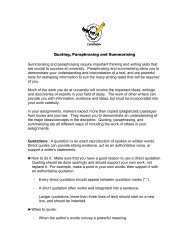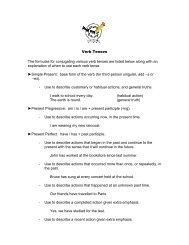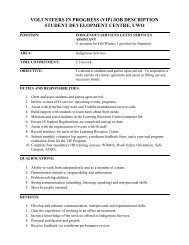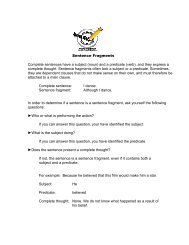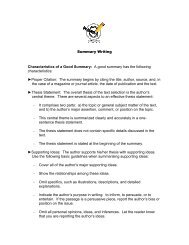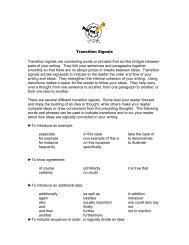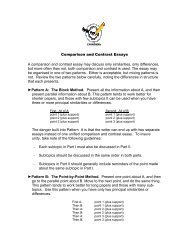Essays: General Structure Introduction: this should be 5-20% of the ...
Essays: General Structure Introduction: this should be 5-20% of the ...
Essays: General Structure Introduction: this should be 5-20% of the ...
Create successful ePaper yourself
Turn your PDF publications into a flip-book with our unique Google optimized e-Paper software.
<strong>Essays</strong>: <strong>General</strong> <strong>Structure</strong><br />
►<strong>Introduction</strong>: <strong>this</strong> <strong>should</strong> <strong>be</strong> 5-<strong>20%</strong> <strong>of</strong> <strong>the</strong> essay length, and <strong>should</strong>:<br />
- Capture <strong>the</strong> reader’s interest<br />
- Clarify ambiguities, give background information, establish context and<br />
significance<br />
- Analyse <strong>the</strong> topic by identifying its parts and scope, and give <strong>the</strong><br />
reader some understanding <strong>of</strong> <strong>the</strong> order in which <strong>the</strong> ideas in <strong>the</strong> essay<br />
will <strong>be</strong> developed.<br />
- Focus <strong>the</strong> reader’s attention on <strong>the</strong> central issue <strong>of</strong> <strong>the</strong> essay and<br />
identify <strong>the</strong> author’s point <strong>of</strong> view in a <strong>the</strong>sis statement. The <strong>the</strong>sis<br />
statement is usually expressed in <strong>the</strong> last sentence <strong>of</strong> <strong>the</strong> introduction.<br />
►Body: <strong>the</strong> body <strong>of</strong> an essay varies in length based on <strong>the</strong> complexity <strong>of</strong> <strong>the</strong><br />
topic and <strong>the</strong> requirements <strong>of</strong> <strong>the</strong> assignment.<br />
- The body is made up <strong>of</strong> paragraphs that develop <strong>the</strong> argument<br />
presented in <strong>the</strong> <strong>the</strong>sis statement.<br />
- Each paragraph must contain a topic sentence that presents one<br />
specific issue or argument related to <strong>the</strong> <strong>the</strong>sis.<br />
- Paragraphs may <strong>be</strong> developed through: explanation <strong>of</strong> <strong>the</strong> issue;<br />
expansion <strong>of</strong> <strong>the</strong> implications raised by <strong>the</strong> issue; providing evidence<br />
for <strong>the</strong> argument, such as quotes, paraphrases, statistics, facts,<br />
examples, illustrations or tables.<br />
- Paragraphs <strong>should</strong> <strong>be</strong> presented in a logical order, and <strong>the</strong> first<br />
sentence <strong>of</strong> each paragraph <strong>should</strong> link it with <strong>the</strong> previous paragraph.<br />
►Conclusion: <strong>this</strong> <strong>should</strong> <strong>be</strong> 5-<strong>20%</strong> <strong>of</strong> <strong>the</strong> essay, and <strong>should</strong>:<br />
- Remind <strong>the</strong> reader <strong>of</strong> <strong>the</strong> key arguments or issues that <strong>the</strong> essay<br />
raises.
- Present details <strong>of</strong> <strong>the</strong> essay in a general statement that sums up <strong>the</strong><br />
argument; <strong>of</strong>ten, a conclusion restates <strong>the</strong> topic or <strong>the</strong>sis statement <strong>of</strong><br />
<strong>the</strong> paper.<br />
- Leave <strong>the</strong> reader with a sense <strong>of</strong> satisfaction that questions have <strong>be</strong>en<br />
answered, or loose ends have <strong>be</strong>en tied up.<br />
- Provide evaluative comment, and make predictions or<br />
recommendations if appropriate.



